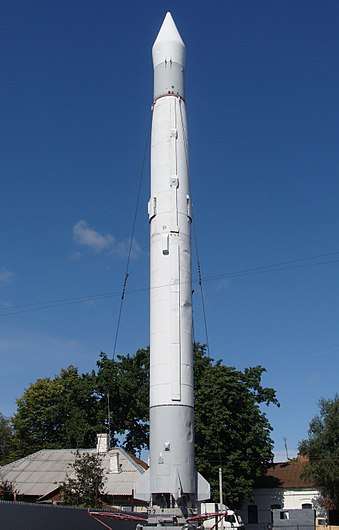R-5 Pobeda
| R-5 | |
|---|---|
 R-5 on display at the Zhytomyr Korolyov Museum | |
| Type |
Theatre ballistic missile Medium-range ballistic missile |
| Place of origin | USSR |
| Service history | |
| In service | 1956-1967 |
| Specifications | |
| Weight | 29,100 kg |
| Length | 20.75 m |
| Diameter | 1.65 m |
| Warhead | 60 \ 80 kt , 300 kt , 1 Mt (or more) thermonuclear warhead |
|
| |
| Engine | RD-103M, 8D52 |
| Wingspan | 3.452 m |
| Propellant | Liquid (92% Ethyl Alcohol/water solution & LOX) |
Operational range | 1,200 km (750 mi)[1] |
Guidance system | inertial guidance plus radio command guidance |
The R-5 Pobeda[2] (Побе́да, "Victory") was a theatre ballistic missile developed by the Soviet Union during the Cold War. The R-5M version was assigned the NATO reporting name SS-3 Shyster and carried the GRAU index 8K51.
The R-5 was originally a development of OKB-1 as a single-stage missile with a detachable warhead reentry vehicle. The R-5M was a nuclear armed missile – the first nuclear missile to be deployed by the Soviet Union – with greater payload and weight but better reliability than its predecessor. The R-5M gave the Soviet Union the ability to target many strategic targets in Europe. The R-5M entered service on 21 May 1956 (retired in 1967), and in 1959 was installed at Vogelsang, Zehdenick and Fürstenberg/Havel in East Germany - the first Soviet nuclear missile bases outside the USSR.[3]
R-5 was additionally an oft-reported alternate designation for the K-5 (missile) air-to-air missile.
Specification
- Propellant liquid
- Range 1,200 kilometres (750 mi)
- Period of storage after fueling: 1 hour[4]
- Time of preparation 2.5 hours
- Guidance: inertial guidance plus radio command guidance
- Warhead and Yield 60 \ 80 kt, 300 kt, 1 Mt (or more) thermonuclear warhead
Operators
See also
References
- ↑ http://www.nasic.af.mil/LinkClick.aspx?fileticket=F2VLcKSmCTE%3d&portalid=19
- ↑ Johnston's Archive - SOVIET/RUSSIAN MISSILE DESIGNATIONS
- ↑ Stephen Evans (25 October 2012). "A Soviet missile base in Germany that spy planes never saw". BBC News.
- ↑ "Archived copy". Archived from the original on 31 March 2013. Retrieved 14 September 2015.
External links
| Wikimedia Commons has media related to R-5 (rocket). |